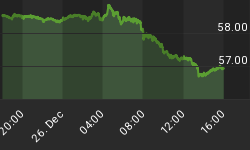Despite—or because of—all the tariffs and the intensifying trade war, the U.S. goods trade deficit reached a record high in October, hitting $77.2 billion, based on Census Bureau data.
Issues of national security aside, one of the key selling points of the trade war has been to reduce America’s trade deficit and make things fair again—so October’s data is a bit of a slap in Washington’s face.
After all, it indicates a steady increase in imports and a decline in exports at the same time. In fact, for five months in a row, the deficit has expanded.
From October to September, the international goods trade deficit widened by 1.3 percent, up $1 billion from $76.3 billion in September.
Imports of goods for October were $217.8 billion, up $0.2 billion from the previous month. At the same time, exports of goods for October were at $140.5 billion, down $0.8 billion from September.

(Click to enlarge)
The Census Bureau data is widely seen as a report card of sorts of the effects of the trade war, and is a new indicator that emerged only in September, alongside the imposition of 10-percent tariffs on $200 billion in Chinese goods, which Trump has threatened to raise to 25 percent in January if the two sides fail to make a deal this weekend at the G20.
While most thought that these tariffs would make Chinese goods too expensive for the American market, American shoppers have so far proved them wrong by buying more imports in October than they did in September, before the tariffs were implemented.
Another theory is that it’s not American shoppers but importers who fear a higher tariff in January and are now stockpiling at the cheaper rate, combined with strong consumer spending power. Related: Brazil Eyes $30 Billion Offshore Oil Boom
Whatever the cause, the deficit—for now—is widening.
Perhaps the dollar is to blame.
Having risen more than 7 percent this year against the currencies of major trading partners, it’s one of those tricky variables that muddy the trade war waters.
As the Washington Post notes, a stronger dollars makes U.S. goods sold abroad more expensive, and imported goods to the U.S. cheaper.
"The dollar is overvalued," said Joseph Gagnon, a former Federal Reserve economist now at the Peterson Institute for International Economics, told the Washington Post. "We have a bigger trade deficit than can be explained by fundamentals."
Those fundamentals are Trump’s $1.5-trillion tax cut and spending policies that continue to push the dollar higher.
Related: How President Trump Is Undermining U.S. Oil Producers
Fundamentally, few see this data going any other way, soon.
Speaking to CNN, Barclays economist Pooja Sriram cited tax cuts that put money back into American pockets, lifting demand for imports—regardless of expense.
“We believe that domestic demand is likely to be sufficiently robust so as to keep imports elevated even after any additional tariffs,” Sriram said.
By that logic, what happens this weekend at the G20 in Argentina, when Trump and Chinese President Xi meet for a deal-or-no-deal, might not make much of a difference in trade deficit data.
By Fred Dunkley for Safehaven.com
More Top Reads From Oilprice.com:

















